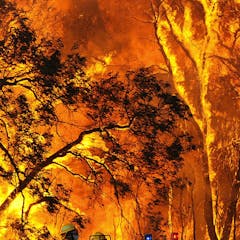
Articles on Fire
Displaying 1 - 20 of 192 articles

A fire that destroyed St. Anne’s Church in Toronto serves as a reminder that cultural legacy needs to be conserved and protected from disaster.

An analysis of 88 million wildfire observations over the past 21 years shows a strong increase in the frequency and intensity of the most extreme fires around the world.

A chemistry professor attempts to bridge the gap between the magical and the biological by exploring the biochemistry of dragon fire.

The 2023 megafires burnt more than 84 million hectares of desert and savannah in northern Australia. That’s larger than the whole of NSW, or more than three times size of the UK.

We compiled maps of bushfires and prescribed burns in southern Australia from 1980 to 2021 to see how fire activity is changing habitat for 129 threatened species such as mountain pygmy possums.

Marsupial rescue, rehabilitation and release statistics from New South Wales and Kangaroo Island during Black Summer fires reveal poor survival rates, despite the courageous efforts of volunteers.

What does fire management do to soils? We compared prescribed burning to cultural burning and looked at how soil properties changed after fire. Cultural burning was better.

Electric vehicles are catching on across the US, but they’re also catching on fire in colder regions like the Northeast and Midwest.

From sacrificial bark to fire-germinating gumnuts to stealthy buds the eucalyptus has evolved an arsenal of protective measures.

We’re all familiar with fire. But do you really know what it is and how it starts? Here’s the chemistry of fire – and why Australia is so prone to going up in flames.

Nearly a third of all moorland burning in Scotland occurs on peat soil – a vital carbon sink.

Electric vehicle batteries have the potential to catch fire, posing a problem for existing infrastructure, especially in enclosed car parks.

Fire is a social equality issue. Amid fresh concerns over rogue landlords and dangerous overcrowding, why have calls for change gone unheeded for so long?

You may have seen contestants on reality shows like “Survivor” make fire using friction, but do you know the physics behind the process?

Yule, celebrated by Wiccans and many other Pagans in the Northern Hemisphere on Dec. 21, the day of the winter solstice, is a time for reflection.

Flame retardants were developed to prevent house fires and help save lives. But they come with some serious health risks.

We used satellite data to create global maps of where and how fires are burning. Fire season lasts two weeks longer than it used to and fires are more intense. But there are regional differences.

Inner city occupations and shack settlements alike are the inevitable consequence of the fact that huge populations of people have to get by without a living wage.

Adapting to our fiery future means preparing for the risks and not putting out every low-risk wildfire, writes the author of a new book on learning to live with fire.

Maui officials have asked relatives to provide DNA samples to help identify victims of the Lahaina wildfires. Time and exposure to the elements, however, can make DNA retrieval from remains difficult.
